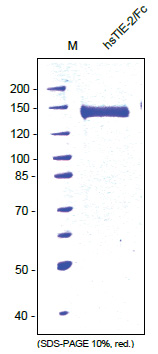CD202b / TEK (Fc Chimera) Mouse Protein
Other products for "Tek"
Specifications
| Product Data | |
| Species | Mouse |
| Expression Host | CHO |
| Expression cDNA Clone or AA Sequence |
GAMDLILINS LPLVSDAETS LTCIASGWHP HEPITIGRDF EALMNQHQDP LEVTQDVTRE WAKKVVWKRE KASKINGAYF CEGRVRGQAI RIRTMKMRQQ ASFLPATLTM TVDRGDNVNI SFKKVLIKEE DAVIYKNGSF IHSVPRHEVP DILEVHLPHA QPQDAGVYSA RYIGGNLFTS AFTRLIVRRC EAQKWGPDCS RPCTTCKNNG VCHEDTGECI CPPGFMGRTC EKACEPHTFG RTCKERCSGP EGCKSYVFCL PDPYGCSCAT GWRGLQCNEA CPSGYYGPDC KLRCHCTNEE ICDRFQGCLC SQGWQGLQCE KEGRPRMTPQ IEDLPDHIEV NSGKFNPICK ASGWPLPTSE EMTLVKPDGT VLQPNDFNYT DRFSVAIFTV NRVLPPDSGV WVCSVNTVAG MVEKPFNISV KVLPEPLHAP NVIDTGHNFA IINISSEPYF GDGPIKSKKL FYKPVNQAWK YIEVTNEIFT LNYLEPRTDY ELCVQLARPG EGGEGHPGPV RRFTTASIGL PPPRGLSLLP KSQTALNLTW QPIFTNSEDE FYVEVERRSL QTTSDQQNIK VPGNLTSVLL SNLVPREQYT VRARVNTKAQ GEWSEELRAW TLSDILPPQP ENIKISNITD STAMVSWTIV DGYSISSIII RYKVQGKNED QHIDVKIKNA TVTQYQLKGL EPETTYHVDI FAENNIGSSN PAFSHELRTL PHSPASADLG TRSDKTHTCP PCPAPELLGG PSVFLFPPKP KDTLMISRTP EVTCVVVDVS HEDPEVKFNW YVDGVEVHNA KTKPREEQYN STYRVVSVLT VLHQDWLNGK EYKCKVSNKA LPAPIEKTIS KAKGQPREPQ VYTLPPSREE MTKNQVSLTC LVKGFYPSDI AVEWESNGQP ENNYKTTPPM LDSDGSFFLY SKLTVDKSRW QQGNVFSCSV MHEALHNHYT QKSLSLSPGK
|
| Predicted MW | 280 kDa |
| Purity | >90% by SDS-PAGE and visualised by silver stain |
| Presentation | Purified |
| Buffer | Presentation State: Purified State: Lyophilized purified protein Buffer System: PBS without stabilizers |
| Reconstitution | Restore in PBS to a concentration not lower than 50 µg/ml. The lyophilized sTIE-2/hFc is soluble in water and most aqueous buffers. |
| Preparation | Lyophilized purified protein |
| Protein Description | Recombinant Murine soluble TIE-2 was fused with the Fc part of human IgG1. The recombinant mature sTIE-2/Fc is a disulfide-linked homodimeric protein. The sTIE-2/Fc monomers have a mass of approximately 105kDa. As a result of glycosylation, the recombinant protein migrates as an approximately 140kDa protein in SDS-PAGE under reducing conditions. The soluble receptor protein consists of the full extracellular domain (Val19-Leu740). |
| Note | Centrifuge vials before opening! |
| Storage | Store lyophilized at 2-8°C for 6 months or at -20°C long term. After reconstitution store the antibody undiluted at 2-8°C for one month or (in aliquots) at -20°C long term. Avoid repeated freezing and thawing. |
| Stability | Shelf life: one year from despatch. |
| Reference Data | |
| RefSeq | NP_001277478 |
| Locus ID | 21687 |
| UniProt ID | Q02858 |
| Cytogenetics | 4 43.34 cM |
| Synonyms | AA517024; Cd202b; Hyk; STK1; Tie-2; Tie2 |
| Summary | Tyrosine-protein kinase that acts as cell-surface receptor for ANGPT1, ANGPT2 and ANGPT4 and regulates angiogenesis, endothelial cell survival, proliferation, migration, adhesion and cell spreading, reorganization of the actin cytoskeleton, but also maintenance of vascular quiescence. Has anti-inflammatory effects by preventing the leakage of proinflammatory plasma proteins and leukocytes from blood vessels. Required for normal angiogenesis and heart development during embryogenesis. Required for post-natal hematopoiesis. After birth, activates or inhibits angiogenesis, depending on the context. Inhibits angiogenesis and promotes vascular stability in quiescent vessels, where endothelial cells have tight contacts. In quiescent vessels, ANGPT1 oligomers recruit TEK to cell-cell contacts, forming complexes with TEK molecules from adjoining cells, and this leads to preferential activation of phosphatidylinositol 3-kinase and the AKT1 signaling cascades. In migrating endothelial cells that lack cell-cell adhesions, ANGT1 recruits TEK to contacts with the extracellular matrix, leading to the formation of focal adhesion complexes, activation of PTK2/FAK and of the downstream kinases MAPK1/ERK2 and MAPK3/ERK1, and ultimately to the stimulation of sprouting angiogenesis. ANGPT1 signaling triggers receptor dimerization and autophosphorylation at specific tyrosine residues that then serve as binding sites for scaffold proteins and effectors. Signaling is modulated by ANGPT2 that has lower affinity for TEK, can promote TEK autophosphorylation in the absence of ANGPT1, but inhibits ANGPT1-mediated signaling by competing for the same binding site. Signaling is also modulated by formation of heterodimers with TIE1, and by proteolytic processing that gives rise to a soluble TEK extracellular domain. The soluble extracellular domain modulates signaling by functioning as decoy receptor for angiopoietins. TEK phosphorylates DOK2, GRB7, GRB14, PIK3R1, SHC1 and TIE1.[UniProtKB/Swiss-Prot Function] |
Documents
| FAQs |
| SDS |
Resources
Recombinant Protein Resources |
{0} Product Review(s)
0 Product Review(s)
Submit review
Be the first one to submit a review
Product Citations
*Delivery time may vary from web posted schedule. Occasional delays may occur due to unforeseen
complexities in the preparation of your product. International customers may expect an additional 1-2 weeks
in shipping.






























































































































































































































































 Germany
Germany
 Japan
Japan
 United Kingdom
United Kingdom
 China
China
